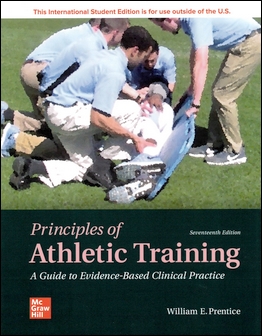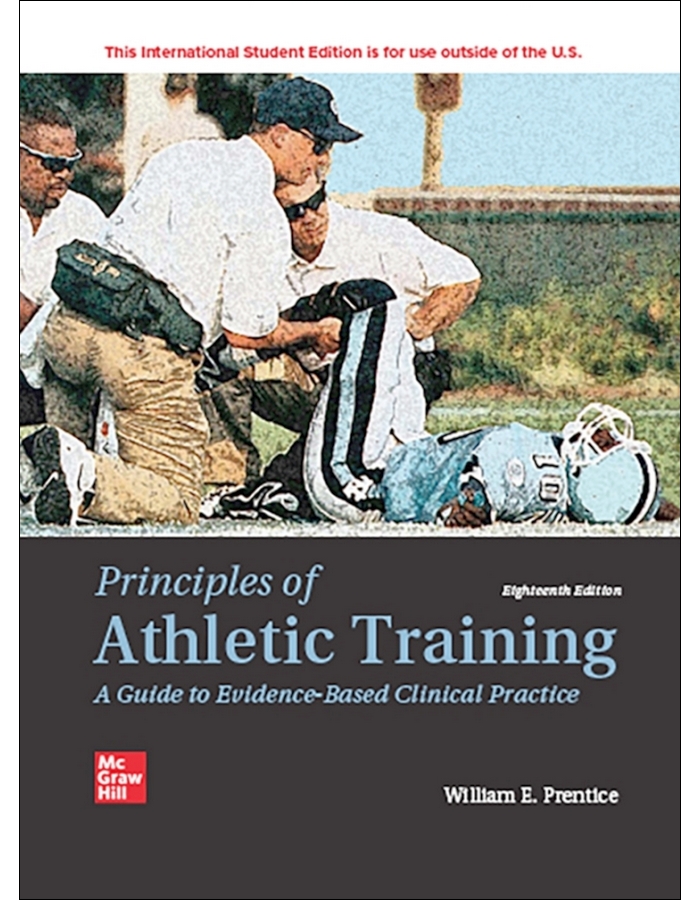(eBook) Principles of Athletic Training: A Guide to Evidence-Based Clinical Practice 17/e
- ◉ VitalSource◉ 閱讀期限:Lifetime
售價
$
1,000
- 電子書
- ISBN:9781260589740
- 作者:William Prentice
- 版次:17
- 年份:2021
- 出版商:McGraw-Hill
- 頁數/規格:電子書
書籍介紹
目錄
►VitalSource 電子書購買須知:
Description
Principles of Athletic Training: A Competency-Based Approach is designed to be used by athletic trainers in courses concerned with the scientific, evidence-based and clinical foundations of athletic training and sports medicine. The text leads the student from general foundations to specific concepts relative to injury prevention, evaluation, management, and rehabilitation. As the student progresses from beginning to end, he or she will understand the complexities of the profession of athletic training. An over-arching goal of the text is to make certain that each and every one of the educational competencies identified by the Education Council is specifically covered. After using this text the student should be able to apply the appropriate techniques and concepts in the day-to-day performance of his or her job as an athletic trainer.
- 閱讀期限:Lifetime
- 電子書兌換碼將於 3-5 個工作天,寄送至「序號寄送 E-mail」所填寫的信箱。
- 根據消費者保護法第 19 條第 1 項規定,本產品為數位內容,售出後恕不接受退貨或退款。
- 本產品僅限台灣境內使用,海外 IP 無法註冊或啟用。
- 電子書平台登錄與註冊說明 (eText-Register.pdf)。
- 電子書平台操作手冊 (eText-Manual.pdf)。
- 如有任何問題,請 Email 至 ebook@tunghua.com.tw。
Description
Principles of Athletic Training: A Competency-Based Approach is designed to be used by athletic trainers in courses concerned with the scientific, evidence-based and clinical foundations of athletic training and sports medicine. The text leads the student from general foundations to specific concepts relative to injury prevention, evaluation, management, and rehabilitation. As the student progresses from beginning to end, he or she will understand the complexities of the profession of athletic training. An over-arching goal of the text is to make certain that each and every one of the educational competencies identified by the Education Council is specifically covered. After using this text the student should be able to apply the appropriate techniques and concepts in the day-to-day performance of his or her job as an athletic trainer.
Table of Contents
PART I: Professional Development and Responsibilities
Chapter 1: The Athletic Trainer as a Health Care Provider
Chapter 2: Health Care Organization and Administration in Athletic Training
Chapter 3: Legal Concerns and Insurance Issues
PART II: Risk Management
Chapter 4: Fitness and Conditioning Techniques
Chapter 5: Nutrition and Supplements
Chapter 6: Environmental Considerations
Chapter 7: Protective Equipment
Chapter 8: Wrapping and Taping
PART III: Pathology of Sports Injury
Chapter 9: Mechanisms and Characteristics of Musculoskeletal and Nerve Trauma
PART IV: Management Skills
Chapter 11: Psychosocial Intervention for Sports Injuries and Illnesses
Chapter 12: On-the-Field Acute Care and Emergency Procedures
Chapter 13: Off-the-Field Injury Evaluation
Chapter 14: Infectious Diseases, Bloodborne Pathogens, and Universal Precautions
Chapter 15: Using Therapeutic Modalities
Chapter 16: Using Therapeutic Exercise in Rehabilitation
Chapter 17: Pharmacology, Drugs, and Sports
PART V: Musculoskeletal Conditions
Chapter 18: The Foot
Chapter 19: The Ankle and Lower Leg
Chapter 20: The Knee and Related Structures
Chapter 21: The Thigh, Hip, Groin, and Pelvis
Chapter 22: The Shoulder Complex
Chapter 23: The Elbow
Chapter 24: The Forearm, Wrist, Hand, and Fingers
Chapter 25: The Spine
PART VI: General Medical Conditions
Chapter 26: The Head, Face, Eyes, Ears, Nose, and Throat
Chapter 27: The Thorax and Abdomen
Chapter 28: Skin Disorders
Chapter 29: Additional General Medical Conditions
Appendix A: Addresses of Professional Sports Medicine Organizations
Appendix B: NATA Position, Official, Consensus, and Support Statements
Appendix C: Sports Medicine–Related Journals
Appendix D: Sample Resume
Appendix E: NATA Code of Ethics
Appendix F: Manual Muscle Tests
Appendix G: Goniometric Measurements of Range of Motion
PART I: Professional Development and Responsibilities
Chapter 1: The Athletic Trainer as a Health Care Provider
Chapter 2: Health Care Organization and Administration in Athletic Training
Chapter 3: Legal Concerns and Insurance Issues
PART II: Risk Management
Chapter 4: Fitness and Conditioning Techniques
Chapter 5: Nutrition and Supplements
Chapter 6: Environmental Considerations
Chapter 7: Protective Equipment
Chapter 8: Wrapping and Taping
PART III: Pathology of Sports Injury
Chapter 9: Mechanisms and Characteristics of Musculoskeletal and Nerve Trauma
PART IV: Management Skills
Chapter 11: Psychosocial Intervention for Sports Injuries and Illnesses
Chapter 12: On-the-Field Acute Care and Emergency Procedures
Chapter 13: Off-the-Field Injury Evaluation
Chapter 14: Infectious Diseases, Bloodborne Pathogens, and Universal Precautions
Chapter 15: Using Therapeutic Modalities
Chapter 16: Using Therapeutic Exercise in Rehabilitation
Chapter 17: Pharmacology, Drugs, and Sports
PART V: Musculoskeletal Conditions
Chapter 18: The Foot
Chapter 19: The Ankle and Lower Leg
Chapter 20: The Knee and Related Structures
Chapter 21: The Thigh, Hip, Groin, and Pelvis
Chapter 22: The Shoulder Complex
Chapter 23: The Elbow
Chapter 24: The Forearm, Wrist, Hand, and Fingers
Chapter 25: The Spine
PART VI: General Medical Conditions
Chapter 26: The Head, Face, Eyes, Ears, Nose, and Throat
Chapter 27: The Thorax and Abdomen
Chapter 28: Skin Disorders
Chapter 29: Additional General Medical Conditions
Appendix A: Addresses of Professional Sports Medicine Organizations
Appendix B: NATA Position, Official, Consensus, and Support Statements
Appendix C: Sports Medicine–Related Journals
Appendix D: Sample Resume
Appendix E: NATA Code of Ethics
Appendix F: Manual Muscle Tests
Appendix G: Goniometric Measurements of Range of Motion


